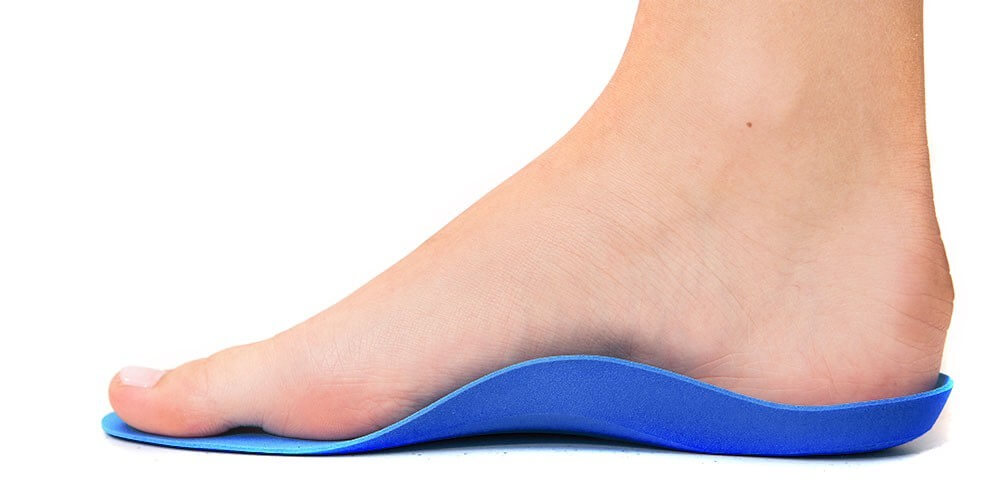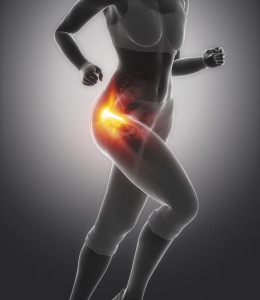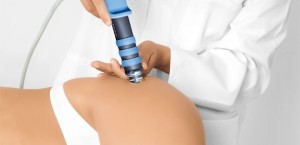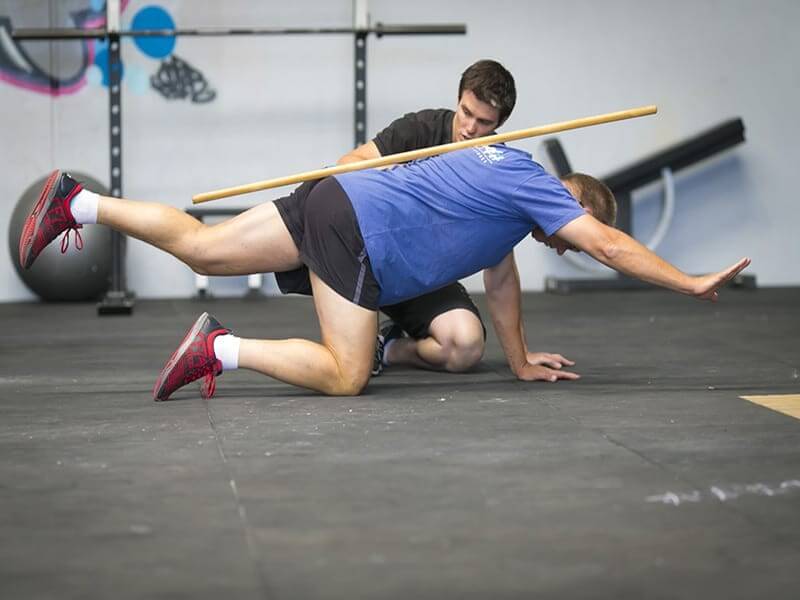
What is Trochanteric Bursitis?
 Trochanteric
bursitis (TB) is a common problem seen by sports medicine practitioners, affecting as many as 5.6 patients per 1000 adults.1
Trochanteric
bursitis (TB) is a common problem seen by sports medicine practitioners, affecting as many as 5.6 patients per 1000 adults.1
Sometimes described as “greater trochanteric pain syndrome,” TB is characterized by chronic lateral hip pain exacerbated by active abduction, passive adduction, and direct palpation.1,2 The iliotibial band (ITB) and fascia lata act as a lateral tension band to resist tensile strains on the concave aspect of the femur 3 and is often implicated as the source of TB. Gluteus medius tears, also referred to as the “rotator cuff tears of the hip,” are found in up to 22% of elderly patients and may also be an underlying cause of lateral hip pain.4 Although the incidence of TB is highest in middle-aged to elderly adults,5 the etiology is multifactorial and TB can affect patients of all ages.
Recurrence is common with TB, and patients frequently undergo multiple courses of nonoperative treatment, experiencing only temporary and incomplete pain relief. For severe refractory cases, multiple small case series in the recent literature have described surgical options for TB. Surprisingly, there are relatively few high-level studies examining the efficacy of operative and nonoperative treatment of this often minimized yet troublesome condition. The purpose of this study was to perform a systematic review of the literature on patient satisfaction and functional outcome after different treatment modalities for TB and refractory TB.
Lateral hip pain is a common complaint addressed by physiotherapists, orthopedists, sports medicine specialists, and primary care physicians. Although it can arise from numerous different underlying acute and chronic pathologies, it is frequently diagnosed as TB and almost universally treated initially with conservative measures. Nevertheless, it can be a frustrating syndrome to patients and clinicians alike, and many are unaware of the availability and efficacy of more advanced therapeutic options. The challenging nature of accurately diagnosing TB as a cause of lateral hip pain is undeniable.
The Evidence for Treatment:
Corticosteroid Injections:
For most patients, a single corticosteroid injection provides a tangible improvement in symptoms and decrease in pain from a moderate to a low level. Older studies from the 1980s tend to report better subjective responses to injection than more recent articles but typically lack validated clinical outcome scores. In some cases of TB, multiple injections and other modalities, such as PT, ultrasound, and NSAIDs, are necessary.

Shockwave Therapy:
Shockwave Therapy has been identified as a successful treatment option than other conservative therapies, such as home exercise programs. Low-energy Shockwave Therapy has been shown to be superior to corticosteroid injection and home therapy and may be the next step for patients who fail conservative management.

Surgical Outcomes:
Surgical treatment has demonstrated success. There are several options to consider; the least invasive is endoscopic bursectomy, and the most invasive is open osteotomy. Repairing tears to gluteus medius and gluteus minimus has also been shown to be quite beneficial in managing recalcitrant lateral hip pain, and the possibility of such tears as an underlying etiology warrants careful consideration. However, in the reported series, concomitant bursectomy or ITB windowing procedures were performed. This makes it difficult to determine the contribution of the gluteal muscle repair to the overall improvement from the surgery. The most common procedures focus on relieving the tension of the ITB with either longitudinal release or Z-plasty.
References
1. Brinks A, van Rijn R, Bohnen A, et al. Effect of corticosteroid injection for trochanter pain syndrome: design of a randomised clinical trial in general practice. BMC Musculoskelet Disord. 2007;8:95. Bibliographic Links [Context Link]
2. Karpinski M, Piggott H. Greater trochanteric pain syndrome. A report of 15 cases. J Bone Joint Surg Br. 1985;67:762-763. [Context Link]
3. Radin E. Biomechanics of the human hip. Clin Orthop Relat Res. 1980;152:28-34. [Context Link]
4. Bunker T, Esler C, Leach W. Rotator-cuff tear of the hip. J Bone Joint Surg Br. 1997;79:618-620. Bibliographic Links [Context Link]
5. Lievense A, Bierma-Zeinstra S, Schouten B, et al. Prognosis of trochanteric pain in primary care. Br J Gen Pract. 2005;55:199-204. Bibliographic Links [Context Link]
6. Sayegh F, Potoupnis M, Kapetanos G. Greater trochanter bursitis pain syndrome in females with chronic low back pain and sciatica. Acta Orthop Belg. 2004;70:423-428. Bibliographic Links [Context Link]
7. Brooker AJ. The surgical approach to refractory trochanteric bursitis. Johns Hopkins Med J. 1979;145:98-100. Bibliographic Links [Context Link]
8. Wright J, Swiontkowski M, Heckman J. Introducing levels of evidence to the journal. J Bone Joint Surg Am. 2003;85:1-3. Ovid Full Text Bibliographic Links [Context Link]
9. Cohen S, Strassels S, Foster L, et al. Comparison of fluoroscopically guided and blind corticosteroid injections for greater trochanteric pain syndrome: multicentre randomised controlled trial. BMJ. 2009;338:986-988. [Context Link]
10. Farmer K, Jones L, Brownson K, et al. Trochanteric bursitis after total hip arthroplasty. J Arthroplasty. 2010;25:208-212. [Context Link]
11. Furia J, Rompe J, Maffulli N. Low-energy extracorporeal shock wave therapy as a treatment for greater trochanteric pain syndrome. Am J Sports Med. 2009;37:1806-1813. Bibliographic Links [Context Link]
12. Shbeeb M, O’Duffy J, Michet CJ, et al. Evaluation of glucocorticosteroid injection for the treatment of trochanteric bursitis. J Rhematol. 1996;23:2104-2106. [Context Link]
13. Rasmussen K, Fano N. Trochanteric bursitis. Treatment by corticosteroid injection. Scan J Rheumatol. 1985;14:417-420. [Context Link]
14. Govaert L, van der Vis H, Marti R, et al. Trochanteric reduction osteotomy as a treatment for refractory trochanteric bursitis. J Bone Joint Surg Br. 2003;85:199-203. Bibliographic Links [Context Link]
15. Iorio R, Healy W, Warren P, et al. Lateral trochanteric pain following primary total hip arthroplasty. J Arthroplasty. 2006;21:233-236. [Context Link]
16. Raman D, Haslock I. Trochanteric bursitis—a frequent cause of ‘hip’ pain in rheumatoid arthritis. Ann Rheum Dis. 1982;42:591-592. [Context Link]
17. Rompe J, Segal N, Cacchio A, et al. Home training, local corticosteroid injection, or radial shock wave therapy for greater trochanteric pain syndrome. Am J Sports Med. 2009;37:1981-1990. Bibliographic Links [Context Link]
18. Wiese M, Rubenthaler F, Willburger R, et al. Early results of endoscopic trochanter bursectomy. Int Orthop. 2004;28:218-221. Bibliographic Links [Context Link]
19. Craig R, Gwynne Jones D, Oakley A, et al. Iliotibial band Z-lengthening for refractory trochanteric bursitis (greater trochanteric pain syndrome). ANZ J Surg. 2007;77:996-998. Bibliographic Links
20. Chirputkar K, Weir P, Gray A. Z-lengthening of the iliotibial band to treat recalcitrant cases of trochanteric bursitis. Hip Int. 2007;17:31-35. Bibliographic Links
21. Slawski D, Howard R. Surgical management of refractory trochanteric bursitis. Am J Sports Med. 1997;25:86-89. Bibliographic Links
22. Baker CJ, Massie R, Hurt W, et al. Arthroscopic bursectomy for recalcitrant trochanteric bursitis. Arthroscopy. 2007;23:827-832. Bibliographic Links
23. Schapira D, Nahir M, Scharf Y. Trochanteric bursitis: a common clinical problem. Arch Phys Med Rehabil. 1986;67:815-817.
24. Pretell J, Ortega J, Garcia-Rayo R, et al. Distal fascia lata lengthening: an alternative surgical technique for recalcitrant trochanteric bursitis. Int Orthop. 2009;33:1223-1227.
25. Sayed-Noor A, Pederson E, Wretenberg P, et al. Distal lengthening of ilio-tibial band by Z-plasty for treating refractory greater trochanteric pain after total hip arthroplasty (Pederson-Noor operation). Arch Orthop Trauma Surg. 2009;129:597-602.
26. Kagan A. Rotator cuff tears of the hip. Clin Orthop Relat Res. 1999;368:135-140. [Context Link]
27. Lequesne M, Djian P, Vuillemin V, et al. Prospective study of refractory greater trochanter pain syndrome. MRI findings of gluteal tendon tears seen at surgery. Clinical and MRI results of tendon repair. Joint Bone Spine. 2008;75:458-464. [Context Link]
28. Voos J, Shindle M, Pruett A, et al. Endoscopic repair of gluteus medius tendon tears of the hip. Am J Sports Med. 2009;37:743-747. Bibliographic Links [Context Link]
29. Davies H, Zhaeentan S, Tavakkolizadeh A, et al. Surgical repair of chronic tears of the hip abductor mechanism. Hip Int. 2009;19:372-376. Bibliographic Links [Context Link]


